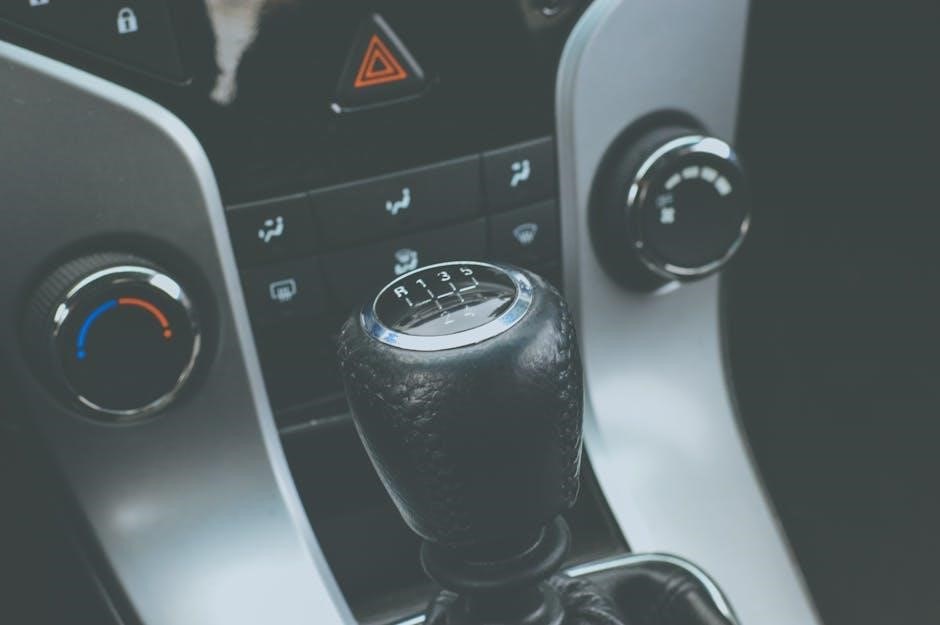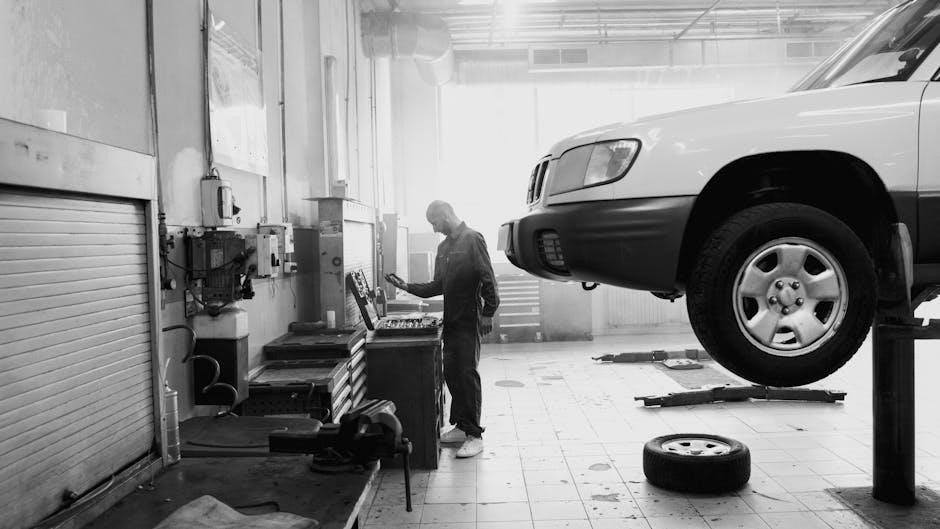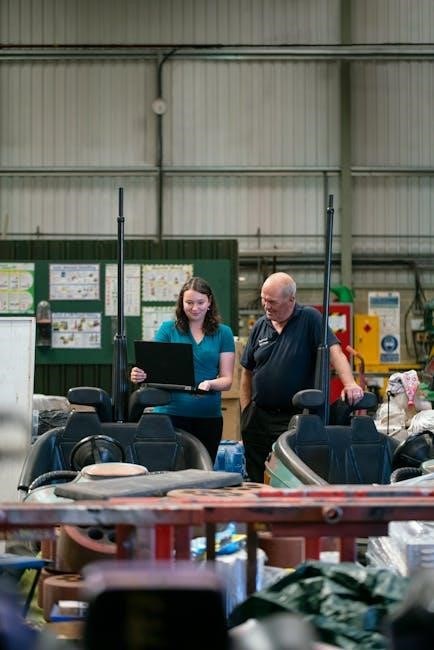The 2007 Chrysler Sebring is a mid-size sedan known for its sleek design‚ fuel efficiency‚ and advanced safety features. This guide provides essential information for owners‚ including maintenance tips‚ troubleshooting common issues‚ and understanding the vehicle’s systems to ensure optimal performance and longevity.
1.1 Overview of the 2007 Chrysler Sebring
The 2007 Chrysler Sebring is a mid-size sedan offering a blend of style‚ comfort‚ and reliability. Available in multiple trims‚ it features a range of engine options‚ including a 2.4L 4-cylinder and a 3.5L V6‚ paired with automatic or manual transmissions. Known for its spacious interior‚ advanced safety features‚ and fuel efficiency‚ the Sebring is a practical choice for everyday driving. This guide helps owners understand and maintain their vehicle for optimal performance and longevity.
1.2 Importance of the Owner’s Manual
The owner’s manual is a crucial resource for 2007 Chrysler Sebring owners‚ providing detailed information on vehicle operation‚ maintenance‚ and troubleshooting. It helps owners understand safety features‚ optimal driving practices‚ and how to address common issues. Regularly referencing the manual ensures proper vehicle care‚ prevents potential problems‚ and maximizes performance. Storing it in the vehicle guarantees easy access and benefits future owners.

Vehicle Identification
Vehicle identification is crucial for maintenance and repairs‚ helping owners understand their car’s specifics. This section covers VIN‚ engine‚ and transmission details‚ guiding owners through essential information.
2;1 Vehicle Identification Number (VIN)
The Vehicle Identification Number (VIN) is a unique 17-character code assigned to each vehicle. It provides essential information about the car‚ such as make‚ model‚ year‚ engine type‚ and production details. For the 2007 Chrysler Sebring‚ the VIN can be found on the driver’s side dashboard or doorjamb. It is crucial for vehicle registration‚ insurance‚ and maintenance records‚ ensuring accurate identification and parts compatibility.
2.2 Engine Specifications
The 2007 Chrysler Sebring offers two primary engine options: a 2.4L inline-4 cylinder engine and a 3.0L V6 engine. The 2.4L engine delivers 172 horsepower and 165 lb-ft of torque‚ while the 3.0L V6 produces 200 horsepower and 190 lb-ft of torque. Both engines are paired with a 4-speed automatic transmission for smooth performance. The 2.4L option is more fuel-efficient‚ making it ideal for drivers prioritizing economy‚ while the V6 provides enhanced power for a more dynamic driving experience.
2.3 Transmission Details
The 2007 Chrysler Sebring features a 4-speed automatic transmission designed for smooth and efficient performance. This transmission is compatible with both the 2.4L and 3.0L engines‚ offering seamless shifting and optimal power delivery. It includes adaptive electronic control‚ which adjusts shifting based on driving conditions‚ and a torque converter lock-up feature to improve fuel efficiency at higher speeds. The transmission is built for reliability and provides a comfortable driving experience in various road conditions.
Fuel and Emissions
The 2007 Chrysler Sebring features emission control systems to minimize environmental impact and offers fuel economy ratings designed for efficient performance.
3.1 Recommended Fuel Types
For optimal performance‚ the 2007 Chrysler Sebring requires regular unleaded gasoline with an octane rating of 87. Using higher-octane fuel is unnecessary unless specified for certain engine variants. Proper fuel selection ensures better engine efficiency‚ fuel economy‚ and reduced emissions. Always avoid using diesel or E85‚ as they can damage the fuel system. Refer to the owner’s manual for specific recommendations tailored to your vehicle’s configuration.
3.2 Emission Control Systems
The 2007 Chrysler Sebring is equipped with advanced emission control systems to minimize environmental impact. These include a catalytic converter‚ oxygen sensors‚ and a fuel evaporative system. The Powertrain Control Module (PCM) monitors and adjusts emissions for optimal performance. Regular maintenance‚ such as inspecting the oxygen sensor and ensuring proper fuel system function‚ is essential to maintain efficiency and comply with emissions standards. Proper functioning ensures reduced pollutants and improved fuel efficiency.
3.3 Fuel Economy and Efficiency
The 2007 Chrysler Sebring offers an estimated fuel economy of up to 22 MPG in the city and 30 MPG on the highway‚ depending on the engine and driving conditions. Factors such as driving habits‚ tire pressure‚ and additional weight can impact efficiency. Regular maintenance‚ including oil changes and air filter replacements‚ helps maintain optimal performance. Driving at steady speeds and avoiding excessive idling can also improve fuel efficiency‚ contributing to greater cost savings and reduced emissions over time.
Maintenance Schedule
Regular maintenance ensures optimal performance and longevity. Follow the recommended schedule for oil changes‚ tire rotations‚ and fluid checks. Neglecting maintenance can reduce efficiency and cause damage.
4.1 Recommended Maintenance Intervals
For the 2007 Chrysler Sebring‚ routine maintenance is crucial. Oil changes are recommended every 5‚000 to 7‚500 miles. Tire rotations should occur every 6‚000 to 8‚000 miles. Brake pads should be inspected every 12‚000 miles‚ and spark plugs replaced every 30‚000 miles. Regular checks of air filters and belts are also essential to prevent unexpected failures and maintain fuel efficiency.
4.2 Importance of Regular Maintenance
Regular maintenance is crucial for the 2007 Chrysler Sebring to ensure optimal performance‚ reliability‚ and longevity. It helps prevent costly repairs by identifying potential issues early. Routine checks of fluids‚ belts‚ and tires can enhance fuel efficiency and safety. Neglecting maintenance may lead to breakdowns and premature wear of critical components. Consistent upkeep also preserves the vehicle’s value and ensures a smoother driving experience over time.
4.3 DIY Maintenance Tips
Regularly check and top off fluids like oil‚ coolant‚ and transmission fluid to maintain engine health. Inspect and replace the air filter every 15‚000 miles to improve fuel efficiency. Check tire pressure monthly and rotate tires every 6‚000 miles for even wear. Clean battery terminals to prevent corrosion and ensure reliable starts. These simple tasks can prevent major issues and keep your Sebring running smoothly.

Troubleshooting Common Issues
Identify and resolve common problems like stalling or check engine lights using diagnostic codes. Consult the manual for solutions and guidelines to address these issues effectively.
5.1 Common Problems and Solutions
Common issues with the 2007 Sebring include engine stalling‚ faulty sensors‚ and transmission problems. Solutions often involve replacing sensors‚ updating software‚ or checking connections. Regular maintenance‚ like replacing spark plugs and sensors‚ can prevent these issues. Always refer to the manual for specific guidance and troubleshooting steps to address these problems effectively and maintain your vehicle’s performance. Proper diagnosis ensures timely and cost-effective repairs.
5.2 Diagnostic Trouble Codes (DTCs)
Diagnostic Trouble Codes (DTCs) help identify issues in your 2007 Sebring. Codes like P0533 indicate problems with the AC pressure sensor circuit. Use a scan tool to retrieve codes from the PCM. Common issues include sensor malfunctions‚ faulty wiring‚ or system errors. Addressing codes promptly prevents further damage. Always consult the manual or a repair guide for accurate diagnosis and repairs to ensure your vehicle runs smoothly and efficiently. Ignoring DTCs can lead to costly repairs.
5.3 Resetting the Check Engine Light
To reset the check engine light on your 2007 Sebring‚ use a scan tool to clear the Diagnostic Trouble Codes (DTCs) after addressing the underlying issue. Alternatively‚ disconnect the negative battery terminal for 10-15 minutes to reset the system. However‚ ensure the problem is fixed first‚ as the light will return if the issue persists. Always refer to the manual or a repair guide for proper procedures to avoid further complications or damage to your vehicle.

Understanding the Instrument Cluster
The instrument cluster displays essential vehicle information‚ including speed‚ fuel level‚ and warning lights. It helps monitor performance and alerts drivers to potential issues‚ ensuring safe operation.
6.1 Gauges and Indicators
The 2007 Sebring’s instrument cluster features a speedometer‚ tachometer‚ fuel gauge‚ and temperature indicator; These gauges provide real-time data on vehicle performance‚ ensuring drivers stay informed. Indicator lights signal system status‚ such as turn signals and high beams‚ while warning lights alert to issues like low oil pressure or faulty brakes. Familiarizing yourself with these elements is crucial for safe and efficient driving.
6.2 Warning Lights and Their Meanings
The 2007 Sebring features various warning lights on the instrument cluster‚ each signaling specific system statuses or issues. The Check Engine Light indicates engine problems‚ while the Oil Pressure Light warns of low oil levels. Brake and ABS lights alert to braking system issues‚ and the Battery Light signals alternator or charging system faults. Understanding these indicators is crucial for addressing problems promptly and ensuring vehicle safety and performance.
6.3 Customizing the Instrument Cluster
The 2007 Sebring allows drivers to customize the instrument cluster for a personalized experience. Adjustments include brightness settings and menu preferences‚ accessible via buttons on the steering wheel or cluster. Advanced features‚ such as trip information and system status displays‚ can also be tailored. Refer to the manual for specific steps to modify settings and enhance your driving experience with ease.
Heating‚ Ventilation‚ and Air Conditioning (HVAC)
The 2007 Sebring’s HVAC system offers both manual and dual-zone controls for optimal comfort. Adjust temperature‚ airflow‚ and fan speed with intuitive controls‚ ensuring a pleasant cabin environment.
7.1 Manual Climate Control Features
The 2007 Sebring’s manual climate control system provides straightforward temperature‚ airflow‚ and fan speed adjustments. Drivers can easily manage cabin comfort using the intuitive controls‚ directing air through vents‚ defroster‚ or floor outlets. The system also includes a rear ventilation feature for improved air circulation. This simple yet effective setup ensures personalized climate preferences without complexity‚ making it user-friendly for all drivers.
7.2 Dual-Zone Automatic Climate Control
The 2007 Sebring offers a dual-zone automatic climate control system‚ allowing the driver and passenger to set individual temperature preferences. This advanced feature ensures comfort for both occupants‚ with automatic sensors adjusting airflow and temperature. The system also includes an air quality sensor to improve cabin air purity. This feature enhances overall driving comfort‚ making it a standout option for long trips or shared rides.
7.3 Troubleshooting HVAC Issues
Common HVAC issues in the 2007 Sebring include low airflow‚ temperature fluctuations‚ or malfunctioning sensors. Check the air filter for cleanliness and ensure all vents are unobstructed. If the system fails to cool or heat‚ inspect the refrigerant levels and compressor function. Faulty sensors orBlend door actuators may cause temperature inconsistencies. Refer to the manual for diagnostic steps or consult a professional for complex repairs to restore optimal HVAC performance.

Owning and Driving the 2007 Sebring
Owning the 2007 Sebring offers a blend of comfort and reliability‚ making it ideal for both new and experienced drivers. Regular maintenance ensures optimal performance and longevity.
8.1 Tips for New Owners
New owners of the 2007 Chrysler Sebring should start by thoroughly reading the owner’s manual to understand its features and operation. Regularly check fluid levels‚ tire pressure‚ and battery health to ensure reliability. Familiarize yourself with the instrument cluster and safety features like airbags and anti-lock brakes. For optimal fuel efficiency‚ maintain steady speeds and avoid aggressive driving. Schedule routine maintenance to prolong the vehicle’s lifespan and performance.
8.2 Driving in Different Conditions
Adapt your driving to weather and road conditions for safety and efficiency. In rain or snow‚ reduce speed and increase following distance. Use traction control if equipped. In city driving‚ maintain moderate speeds and avoid aggressive acceleration. On highways‚ cruise control can improve fuel efficiency. For optimal handling‚ ensure proper tire pressure and alignment. Familiarize yourself with the vehicle’s stability systems to enhance control in varying driving scenarios.
8.3 Customizing Your Sebring
Personalize your 2007 Chrysler Sebring to reflect your style and preferences. Exterior modifications can include custom paint jobs‚ alloy wheels‚ or spoilers for a sporty look. Interior upgrades might involve premium seat covers‚ wood trim‚ or aftermarket infotainment systems. Performance enhancements‚ such as engine tuning or exhaust modifications‚ can boost power and efficiency. Always consult the owner’s manual before making changes to ensure compatibility and avoid voiding the warranty.
Safety Features and Precautions
The 2007 Chrysler Sebring includes multiple airbags‚ ABS‚ and electronic stability control. Proper seat belt use and regular maintenance are crucial for safety.
9.1 Standard Safety Features
The 2007 Chrysler Sebring is equipped with advanced safety features‚ including dual front airbags‚ side curtain airbags‚ and a reinforced structure for crash protection. The vehicle also features anti-lock braking system (ABS) and electronic stability control to enhance traction and stability on the road. These features work together to provide a safer driving experience and protect occupants in the event of a collision.
9.2 Proper Use of Seat Belts and Airbags
Seat belts and airbags are critical safety features in the 2007 Chrysler Sebring. Always wear your seat belt correctly‚ ensuring it is securely fastened across your chest and hips. Passengers should also buckle up. The airbag system is designed to deploy in conjunction with seat belts to provide maximum protection during a collision. Never disable the airbag system‚ and avoid placing objects near airbag deployment zones to ensure proper function.
9.3 Safe Driving Practices
Always follow traffic laws and drive defensively. Avoid distractions like using your phone while driving. Maintain a safe distance from other vehicles and adjust your speed according to road conditions. Use the HVAC system to ensure good visibility and comfort. Keep your vehicle well-maintained to prevent unexpected issues. Be cautious in adverse weather and wear your seat belt at all times. Safe driving practices help protect you‚ your passengers‚ and others on the road.
Transmission and Suspension
The 2007 Chrysler Sebring features a smooth-shifting transmission and a responsive suspension system‚ designed for both comfort and performance. Proper maintenance ensures optimal handling and ride quality.
10.1 Understanding the Transmission
The 2007 Chrysler Sebring offers various transmission options‚ including automatic and manual‚ designed to enhance driving experience. The automatic transmission ensures smooth gear shifts‚ while the manual provides driver control. Regular fluid checks and filter replacements are crucial for maintaining transmission health. Proper maintenance prevents common issues like slipping gears and delayed engagement‚ ensuring reliable performance and longevity of the system. Always refer to the manual for specific care instructions.
10.2 Suspension System Overview
The 2007 Chrysler Sebring features a robust suspension system designed for a smooth and stable ride. It includes MacPherson struts in the front and a multi-link rear suspension‚ optimizing handling and comfort. Key components like shock absorbers‚ springs‚ and stabilizer bars work together to minimize vibrations and improve stability. Regular inspections of these parts are essential to maintain ride quality and prevent premature wear. Proper alignment and timely replacements ensure long-term performance and safety.
10.3 Maintenance Tips for Transmission and Suspension
Regular transmission fluid checks and changes are vital to ensure smooth gear shifts and prevent overheating. Inspect the suspension components‚ such as ball joints and bushings‚ for wear and replace them if necessary. Check tire balance and alignment annually to maintain even wear and improve handling. Avoid overloading the vehicle‚ as it can strain the suspension. Schedule professional inspections for both systems annually to ensure optimal performance and longevity.
The 2007 Chrysler Sebring offers a blend of style‚ comfort‚ and performance. Regular maintenance ensures longevity‚ while safe driving practices enhance your ownership experience. Customize and enjoy your ride!
11.1 Summary of Key Points
The 2007 Chrysler Sebring manual emphasizes proper vehicle identification‚ regular maintenance‚ and understanding emissions systems for optimal performance. It highlights troubleshooting common issues like engine stalling and transmission problems‚ while also detailing safety features and HVAC controls. DIY tips and customization options are provided to enhance ownership. By following these guidelines‚ owners can ensure their Sebring operates efficiently and safely for years to come.
11.2 Final Tips for Owners
Regularly review the owner’s manual to stay informed about maintenance and troubleshooting. Schedule routine checks for fluids‚ belts‚ and tire pressure to ensure reliability. Address issues promptly to avoid costly repairs. Familiarize yourself with emission controls and HVAC systems for optimal performance. Keep the vehicle clean and well-maintained to preserve its value. Always refer to Chrysler-approved repair manuals for accurate guidance‚ and stay updated on recalls or software updates for your 2007 Sebring.

Resources and Further Reading
Consult Chrysler’s official website for support‚ or refer to repair manuals like Haynes or Chilton for detailed guidance. Join online forums for owner discussions and advice;
12.1 Contact Information for Chrysler Support
For inquiries or assistance with your 2007 Chrysler Sebring‚ contact Chrysler Customer Service at 1-800-CHRYSLER (1-800-247-9753). Visit their official website at Chrysler.com for support resources‚ manuals‚ and service locations. International customers can find region-specific contact details on the website. Additionally‚ local dealerships can provide personalized assistance and access to genuine parts and services.
12.2 Recommended Repair Manuals and Guides
For accurate repairs‚ use the official Chrysler Service Manual for the 2007 Sebring‚ available online or through local dealerships. Haynes and Chilton manuals are excellent DIY resources‚ offering detailed instructions and diagrams. Additionally‚ online forums and repair guides specific to the Sebring model year can provide valuable insights and solutions. These resources ensure reliable‚ professional-grade repairs and maintenance for your vehicle.
12.3 Online Communities and Forums
Engage with online communities like Chrysler forums‚ Reddit’s automotive groups‚ and specialized Sebring forums for troubleshooting‚ maintenance tips‚ and modifications. These platforms offer valuable insights‚ repair guides‚ and DIY tutorials from experienced owners and mechanics. Participate in discussions to resolve issues‚ share knowledge‚ and access resources tailored to your 2007 Sebring. These forums are indispensable for maximizing your car’s performance and addressing specific concerns effectively.


